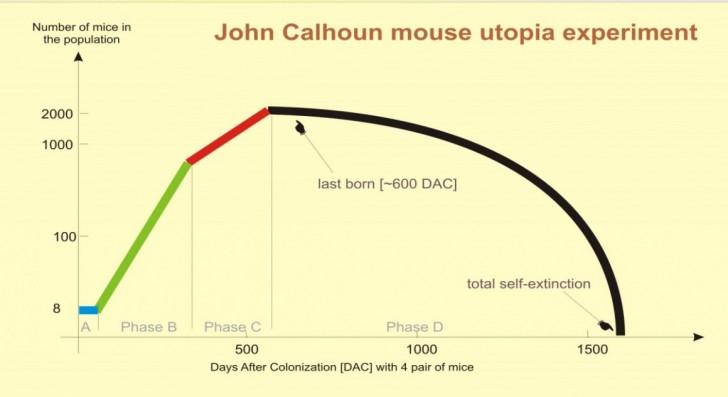

These males kept their harems in private apartments, and had to defend the apartments from challengers. Things got rough for the alpha mice, too. In earlier utopias involving rats, some dropouts even resorted to cannibalism. Every so often, huge brawls would break out among them, vicious free-for-alls of biting and clawing that served no obvious purpose.
RAT UTOPIA EXPERIMENT FULL
And because so few juveniles died, there were suddenly huge hordes of loser mice with nowhere to go.Ĭalhoun called these loser males the “dropouts.” They’d gather in the center of the pen, full of cuts and scars from their lost battles. And normally, a mouse that loses a fight will scurry off to some distant nook to start a new life elsewhere.īut in mouse utopia, the loser mice couldn’t escape. Mice establish dominance by wrestling and biting each other. But among their own kind, there are some tough-guy mice. After all, mice are proverbial cowards-always skittering off in the other direction. That might sound strange, to talk about alpha-mice. You see, mice have strict social hierarchies, with dominant alpha males controlling harems of females. As a result, the pen got overcrowded with youngsters, which introduced several problems. In the wild, most mouse pups get eaten or die of disease or cold. Things weren’t as rosy as they appeared, however. But the population continued to climb until the 20th month, when it peaked at 2200 mice.

The first mouse pups were born after 3½ months, and the population doubled every two months afterward. You can imagine them thinking, “Wait, something has to be wrong here, right?”īut once they settled in, life proceeded pleasantly. It took these eight a while to feel comfortable in utopia. Heavenly conditions.Ĭalhoun introduced the first four males and four females-all albino house mice-in July 1968.
RAT UTOPIA EXPERIMENT PLUS
And again, the mice had all the food and water they needed, plus complete freedom from cold, disease, and predators. The walls were also 4½ feet tall, with slick metal siding to prevent mice from escaping.Įach wall had mesh tubes bolted to it that led into tiny mouse apartments-256 total. It was a box 4½ feet square, with soft ground-up corncobs on the floor. He was born and raised in Tennessee, and conducted the mouse utopia studies at the National Institute of Mental Health, or NIMH. John Calhoun looked like the action-movie star Charles Bronson. Because he also knew just how quickly mouse heaven can deteriorate into mouse hell. And by this point, he knew not to expect a happy ending. Officially, Calhoun called this setup the “Mortality-Inhibiting Environment for Mice.” Unofficially, it was mouse heaven.īut the thing is, this wasn’t the first rodent heaven that Calhoun built. A mouse could live to ripe old age there, and never worry about a thing. He also kept away all predators, and screened the mice to eliminate all disease.

Plenty of food and water a perfect climate reams of paper to make cozy nests. In short, Calhoun’s colony was a mouse utopia-a giant pen with everything a mouse could ever desire. Now, what sort of experiment could justify such thundering rhetoric? A colony of mice. Calhoun titled his most famous paper “Death Squared.” And in it, he quotes from the fiery Book of Revelations and invokes the dreaded Four Horseman of the Apocalypse. Most scientific papers are bland-even bloodless. CreditsĪudio Engineer: Jonathan Pfeffer Transcript

These topsy-turvy science tales, some of which have never made it into history books, are surprisingly powerful and insightful. The Disappearing Spoon tells little-known stories from our scientific past-from the shocking way the smallpox vaccine was transported around the world to why we don’t have a birth control pill for men. The Science History Institute has teamed up with New York Times best-selling author Sam Kean to bring a second history of science podcast to our listeners. John Calhoun’s colony was a mouse utopia-a giant pen with everything a mouse could ever desire: plenty of food and water, a perfect climate, and reams of paper to make cozy nests. But the thing is, this wasn’t the first rodent heaven that Calhoun built.


 0 kommentar(er)
0 kommentar(er)
